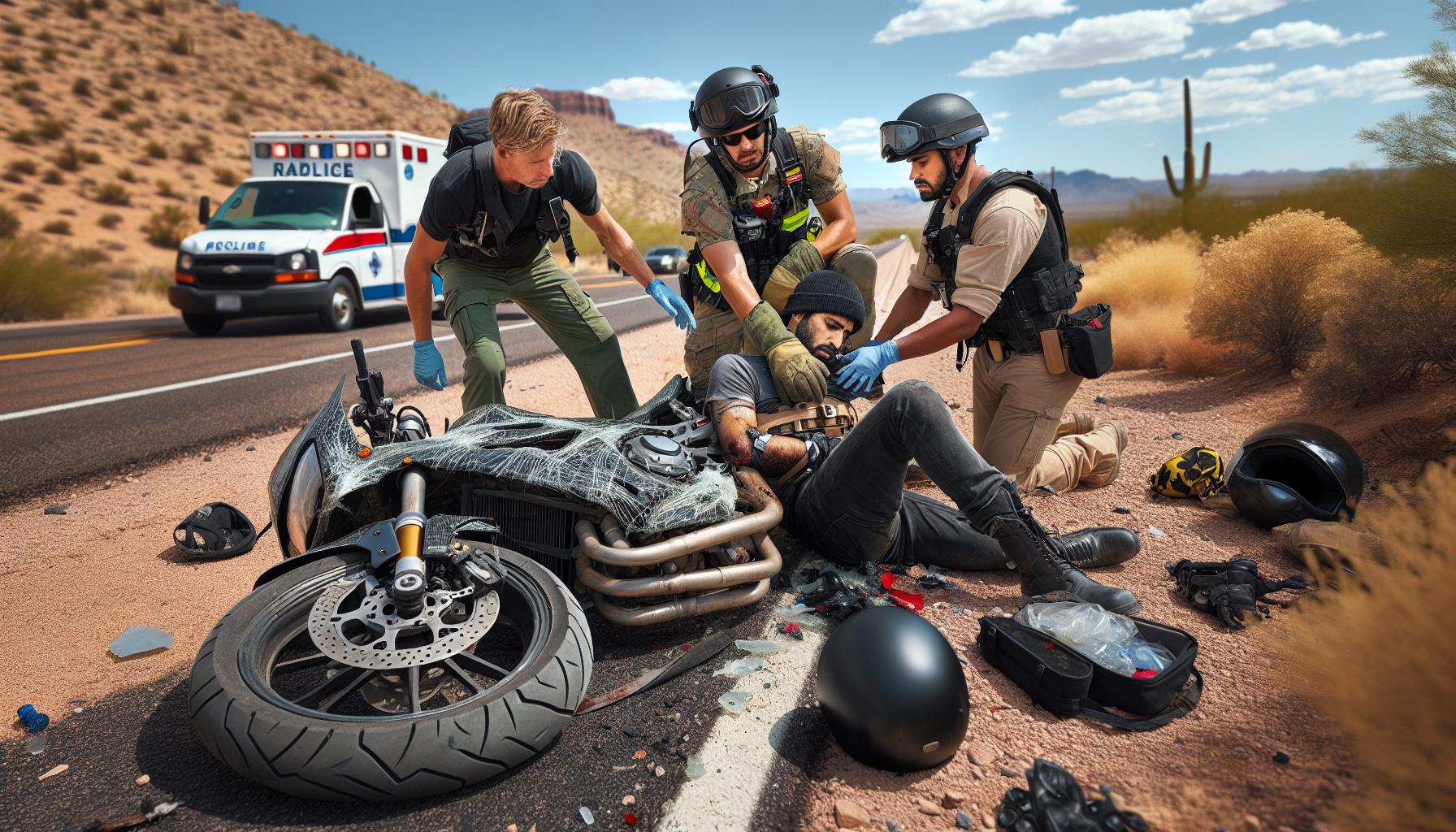Cruising through Arizona’s scenic highways on a motorcycle can be pure bliss until it’s not. Every year thousands of riders face the harsh reality of motorcycle accidents in the Grand Canyon State where the combination of sprawling desert roads and bustling city traffic creates unique challenges for motorcyclists.
From Phoenix’s busy intersections to Tucson’s winding mountain passes motorcycle accidents in Arizona often leave riders dealing with serious injuries medical bills and complex legal battles. While the state’s perfect riding weather draws enthusiasts year-round it’s crucial to understand the legal rights and steps to take after a motorcycle crash. Whether you’re a seasoned rider or just starting to explore Arizona’s breathtaking landscapes on two wheels knowing how to protect yourself legally and financially after an accident isn’t just smart – it’s essential.
Motorcycle Accidents Arizona
Motorcycle accidents in Arizona present distinct challenges due to the state’s unique road conditions and climate. The combination of high temperatures, desert terrain and urban traffic creates specific risk factors for riders across the state.
Common Causes of Arizona Motorcycle Crashes
Driver negligence accounts for 68% of motorcycle collisions in Arizona. Frequent causes include motorists failing to yield right-of-way at intersections, unsafe lane changes without checking blind spots and distracted driving behaviors such as texting. Environmental factors like dust storms, monsoon rains and loose gravel on roadways contribute to single-vehicle accidents. Additional crash triggers involve speeding, improper turns at intersections and rear-end collisions during sudden traffic stops. Road hazards unique to Arizona include sun glare during dawn and dusk hours, wildlife crossings in rural areas and debris blown onto highways during strong winds.
| Location | Annual Accidents | Fatality Rate |
|---|---|---|
| Phoenix Metro | 856 | 12% |
| Tucson | 423 | 9% |
| Rural Highways | 312 | 15% |
Major collision hotspots include Interstate 17 between Phoenix and Flagstaff, the Loop 101 corridor in metropolitan Phoenix and Broadway Boulevard in Tucson. Urban intersections experience the highest concentration of motorcycle crashes during peak traffic hours from 3 PM to 7 PM. Rural highways record increased accident rates during weekend recreational riding, particularly along Routes 87 and 89 through the mountains. The summer months of June through September show elevated crash statistics due to increased tourism traffic combined with extreme weather conditions.
Arizona Motorcycle Laws and Safety Requirements

Arizona enforces specific regulations for motorcycle operation to enhance rider safety across its diverse terrain. These laws establish mandatory equipment standards while setting clear licensing requirements for all riders.
Required Safety Equipment
Arizona law mandates protective eyewear for all motorcycle riders. Riders under 18 must wear DOT-approved helmets that meet Federal Motor Vehicle Safety Standard 218. The state requires motorcycles to have operational headlights running lights windshield or protective eye covering rearview mirrors horn turn signals brakes. Every motorcycle needs two separate brake systems with one controlling the front wheel the other for the rear wheel. Motorcycles manufactured after 1969 must include both left right side mirrors. Handlebar height restrictions limit placement between shoulder level the rider’s seat.
Licensing and Insurance Rules
Arizona requires a Class M motorcycle license or endorsement for operating any motorcycle. Riders obtain this license by passing both written practical tests at the Motor Vehicle Division. The minimum insurance requirements include $25,000 for bodily injury per person $50,000 per accident $15,000 for property damage. First-time applicants complete a Motorcycle Safety Foundation Basic RiderCourse or pass the MVD road test. The state recognizes endorsements from other states through reciprocity agreements. Class M licenses remain valid for 12 years with renewal requirements including vision tests updated photographs. New residents have 30 days to transfer their out-of-state motorcycle license to Arizona.
Common Injuries from Motorcycle Accidents

Motorcycle accidents in Arizona cause severe physical trauma due to limited protection during impact. Riders experience distinct injury patterns that range from surface abrasions to life-threatening conditions.
Medical Treatment and Recovery
Motorcycle crash victims require specialized medical interventions based on injury severity. Road rash treatments involve thorough wound cleaning, debridement of damaged tissue, and antibiotic therapy to prevent infection. Orthopedic injuries demand immediate surgical intervention, followed by extensive physical therapy sessions lasting 6-12 months. Traumatic brain injury patients undergo comprehensive neurological assessments, with treatment protocols including:
- Emergency surgical procedures for reducing brain swelling
- Monitored intensive care for 2-4 weeks
- Cognitive rehabilitation programs lasting 12-24 months
- Physical therapy sessions 3-5 times weekly
- Occupational therapy for basic skill restoration
Long-Term Impact on Victims
Motorcycle accident survivors face persistent physical limitations that affect daily activities. Spinal cord injuries result in partial or complete paralysis, requiring lifetime medical care costing $1.2-4.6 million. Trauma-related conditions include:
- Chronic pain syndromes affecting 75% of survivors
- Permanent mobility restrictions in 60% of cases
- Post-traumatic stress disorder in 32% of victims
- Cognitive impairments affecting 45% of TBI patients
- Career limitations reducing earning capacity by 40-60%
Victims experience ongoing medical expenses, with 80% requiring continued therapeutic interventions for 5+ years post-accident. Insurance claims data indicates permanent disability rates of 35% among motorcycle accident survivors in Arizona.
Legal Rights After a Motorcycle Crash in Arizona

Arizona law protects motorcyclists’ rights to seek compensation after accidents caused by another party’s negligence. Understanding these legal rights enables riders to protect their interests during the claims process.
Filing a Personal Injury Claim
Arizona’s statute of limitations allows motorcycle accident victims 2 years from the crash date to file personal injury claims. Documentation strengthens claims through police reports, medical records, witness statements, photos of injuries, vehicle damage details, insurance information, repair estimates, lost wage documentation, hospital bills, medical treatment costs, doctor’s prognoses, prescriptions, physical therapy records, medical device receipts, and crash scene evidence. Meeting filing deadlines preserves the right to recover damages for medical expenses, lost wages, property damage, disability, emotional trauma, pain, and suffering. A motorcycle accident attorney handles paperwork, gathers evidence, negotiates with insurers, meets deadlines, and represents victim interests in court.
Dealing with Insurance Companies
Insurance companies aim to minimize payouts through quick settlement offers, recorded statements, medical record requests, and liability disputes. Victims maintain their rights by avoiding insurance adjuster discussions without legal representation. Arizona law requires minimum liability coverage of $25,000 per person, $50,000 per accident for bodily injury, and $15,000 for property damage. Uninsured motorist coverage provides additional protection against accidents with uninsured or underinsured drivers. An attorney reviews policy details, calculates damages, negotiates fair settlements, and pursues litigation when insurers act in bad faith. Independent medical evaluations, expert witnesses, and documented evidence strengthen insurance negotiations.
Compensation Available for Accident Victims
Arizona motorcycle accident victims qualify for various types of compensation to address both financial losses and personal suffering after a crash.
Economic Damages
Economic damages cover tangible financial losses resulting from motorcycle accidents. Medical expenses include emergency treatment, surgeries, rehabilitation therapy, prescription medications and ongoing care costs. Lost wages compensate victims for missed work hours, reduced earning capacity and employment benefits. Property damage reimbursement covers motorcycle repairs, replacement costs and damaged personal items. Additional economic damages encompass:
- Transportation expenses for medical appointments
- Home modifications for accessibility
- Medical equipment and mobility devices
- In-home nursing care or assistance
- Job retraining programs
- Future projected medical costs
- Depression and anxiety from trauma
- Post-traumatic stress disorder symptoms
- Sleep disorders and nightmares
- Relationship strain and loss of consortium
- Permanent disfigurement or scarring
- Loss of independence in daily activities
Working with a Motorcycle Accident Attorney
Legal representation proves essential for motorcycle accident victims seeking fair compensation in Arizona. A skilled attorney navigates complex insurance claims processes while protecting the victim’s rights.
When to Hire Legal Representation
Contact an attorney immediately after seeking medical treatment for a motorcycle accident. Critical situations requiring legal counsel include:
- Severe injuries requiring hospitalization or ongoing medical care
- Disputes over accident liability with other parties
- Insurance companies offering low settlement amounts
- Cases involving multiple vehicles or commercial vehicles
- Accidents resulting in permanent disabilities
- Incidents with uninsured or underinsured motorists
- Claims involving defective motorcycle parts
- Fatal accidents requiring wrongful death claims
What to Expect During Your Case
The legal process follows a structured timeline after hiring an attorney:
- Initial case evaluation examines evidence documentation
- Medical records collection demonstrates injury extent
- Insurance company negotiations begin for fair settlements
- Expert witnesses provide testimony supporting claims
- Court filing preparations commence if settlements fail
The attorney handles communication with:
- Insurance adjusters
- Medical providers
- Accident reconstruction specialists
- Defense attorneys
- Court officials
| Phase | Typical Duration |
|---|---|
| Investigation | 1-3 months |
| Settlement Negotiations | 2-6 months |
| Court Filing | 6-18 months |
| Trial Preparation | 3-6 months |
Motorcycle accidents in Arizona present unique challenges that demand careful attention to both prevention and response. Understanding legal rights preparing for potential hazards and maintaining proper safety measures are crucial steps for every rider in the Grand Canyon State.
Riders who find themselves involved in an accident should seek immediate medical attention and consider legal representation to protect their interests. With proper guidance victims can navigate the complex process of recovery and compensation while focusing on what matters most – their health and well-being.
Taking proactive steps to stay safe while understanding the available legal options creates the best foundation for enjoying Arizona’s scenic roads responsibly. The right combination of preparation awareness and legal support can make a significant difference in both preventing and handling motorcycle accidents effectively.

